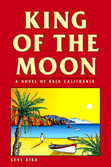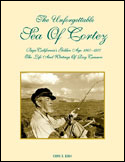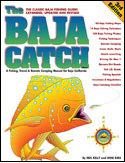Baja summer kayak fishing, new ways in a new century
Mexico Fishing News, August 15, 2001
BAJA COASTAL FISHING REPORTS
ALL ARTICLES, REPORTS AND FISHING INFORMATION FOR BAJA COASTAL AREAS
By Adam "Trout" Traubman
[EDITOR'S NOTE: This is the third of a four-part seasonal series on kayak fishing by expert kayaker Adam "Trout" Traubman. Articles one and two may be found in the archive section of this website and at Dennis Spike's Coastal Kayak Fishing (CKF) website at www.kayakfishing.com. CKF offers kayak fishing schools, clinics and trips for all skill levels, as well as kayak fishing accessories. They can be reached at (818) 345-5824.
"The radical of one century is the conservative of the next. The radical invents the views. When he has worn them out, the conservative adopts them." -- Mark Twain
Summer. It's not just a new season; it's a new century. And I think this quotation fits the bill for exactly what is going on with the sport of kayak fishing right now. Kayak anglers have always evoked quizzical reactions from traditional anglers and only now are we seeing the genesis of mutual respect. It took some pretty big fish from the 'yaks to bridge the gap between "us" and "them" but the important thing is that we are moving away from the dichotomy between kayaks and boats. Anglers are finally realizing that kayaks are legitimate fishing vessels, and in some cases better.
I open with these thoughts in mind because this will be the most crowded summer of fishing in the history of our local fisheries and a decision must be made prior to entering the water that we will all practice basic etiquette and respect all levels of anglers. Whether longboard or kayak or small power boat or large party boat, size should not determine the hierarchy in what was once considered the food chain of fishing vessels. We share the right to enjoy this timeless sport one in the same.
Though most call this season "summer," I prefer "Showtime." It's a fusion of energy, excitement, motion, color, aggression, bewilderment, tranquility and intuition. Visible pandemonium within a bedlam of boils rage just off the beach - your destiny is there. How many gamefish will kayaks bring us this summer? Let me count the ways: yellowfin, dorado, pargo, roosterfish, yellowtail, white sea bass, thresher sharks, grouper and the list goes on.
Not too long ago, many of these fish were deemed "power boat only" species, but the implementation of today's sit-on-top kayak has opened the door for anyone willing to commit to this mano a mano approach. Below are a few mental and physical pointers and features of the sport that will open new doors and help you reach your peak in summertime kayak fishing.
My winter and spring articles covered the beginner and intermediate aspects of kayak fishing, so by now those that have put it all in motion should be comfortable entering and exiting the surf, dealing with gear on the water and being mobile around the kayak in terms of fighting fish and accessing hatches. Both fishing and paddling skills should be developed, but always improving. Smaller inshore species such as bass and rockfish are still entertaining, but an increasing desire is starting to burn for some bigger game and sweeter table fare. This is all the natural, developmental process of kayak fishing, both mentally and physically. It is in our human nature to want bigger, better and more of it!
Southern California and Northern Baja kayak fishing exhibits the most species diversity in the summer - everything is in. Since most kayak anglers have already faced bass, barracuda, bonita, halibut, rockfish and perhaps a random white sea bass, the key to summertime kayak fishing is yellowtail. I don't think I'm risking too much by claiming that the yellowtail is the most sought-after species from the kayak in local fisheries. A few seasonal days are spent targeting white sea bass or a big thresher shark, but on a day-to-day basis, yellowtail is the main attraction. These pelagics brawl from start to finish, make excellent table fare (raw, seared or cooked through) and redefine beauty. Iridescent skin shines off their torpedo-like bodies with extreme silvers, whites, blues and greens, while a vibrant yellow stripe and fork-tail round out their unmistakable guise.
While many power boaters find these jacks miles out to sea, kayak anglers are lucky enough to find the migratory fish in as tight as one-half mile offshore or less, depending on structure, depth and water temperature of the fishery. While I have caught yellowtail on everything from squid to rapalas to plastic swimbaits to iron, the most success has come from live mackerel. Whether it's trolling in blue water or fly-lining around the edges of the inshore kelp canopy, it's up to the kayak angler to track the fish and offer the proper presentation. With smaller mackerel, one hook is sufficient; larger ones occasionally demand a small trap hook for short bites.
Once hooked, let the kayak and your fishing gear do the work. Yellowtail are prone to stripping quite a bit of line on the initial runs, but this can be minimized by allowing the fish to tow you (this is the "sleigh ride" that I mentioned in previous articles). The kayak acts as a natural drag and will eventually tire the fish out. The end of the fight is almost always the same and the kayak angler has the choice of fighting it either straddling the kayak or sitting "side-saddle" while going through the following scenario: (1) after long runs, the fight turns into a straight up-and-down battle (2) the fish begins to circle and the distinctive tail-beat signals "yellowtail" (3) the fish slows down and now it's time to ready the gaff and open the hatch or game bag, while it continues to come up in circles (4) the yellowtail comes to color and eventually 'yakside (5) keeping pressure on the line, the angler gaffs the fish with the hook pointing away from his or her leg and, with one swift motion, swings the fish into the hatch or bag. The drag is only buttoned down if the hookup takes place in or around kelp or abrasive, craggy structure when time is of the essence.
Though yellowtail make up the majority of kayak anglers' happy days on the water, everything changes once the attention is directed toward southern Baja. Aside from the giddy feeling we tend to get when thinking about Baja road trips, hammock siestas in the palapa shade, authentic pescado entero con tortillas, frijoles, arroz y salsa fresca, and tranquil waters off the amber, desert shoreline, nobody can resist the coveted treasures of southern Baja that are easily accessible via kayak. The ultimate game fish are there for the taking and there is nothing greater than rumbling with yellowfin tuna, dorado, roosterfish, pargo and sailfish from a kayak. These species, especially the sailfish, all demand the utmost respect and caution, whether it's from natural, external weapons (i.e., bills or spines), powerful jaws, sharp teeth or pure muscle. Just ask CKF's Dennis Spike who successfully caught and released a 120-pound sailfish from the 'yak last year. I strongly recommend that only experienced kayak anglers participate in this level of kayak fishing. I also advise the group hiring a panga for on-the-water support. Sharing the panga fee, bait and tipping is well worth the "chaperone" that will assist with bigger fish, emergency situations, icing catches and carrying heavy essentials such as food and water. I recommend that beginner and intermediate kayak anglers fish the same general waters, but limited to one-quarter to one-half mile offshore or less. There are still plenty of hard-fighting, tasty fish, and all will fall for artificial lures and jigs.
While the majority of artificials are limited to blue/white, chrome, chrome/blue, scrambled egg and all-white when fishing from the 'yaks locally, southern Baja adds a twist to the tackle with the incorporation of bright colors, various materials and bizarre patterns. These fish bite on some outrageous lures, including neon hoochies, feathers and fish skins. I can guarantee that Gary Graham's success with southern Baja fly fishing will increase the number of kayak anglers fly fishing this season from a trickle to a waterfall. Mike Allen of Coastal Kayak Fishing, Inc. (CKF) is leading the way and, as a certified fly caster and instructor, has already taken his fair share of game fish from various big game fisheries such as the East Cape, Northern Baja and even Hawaii.
So with all of this talk of tuna and dorado some of the local kayak anglers may ask the common question, "Do I have to spend a grand to catch one?" Luckily the answer is NO and the solution comes in the form of a mothership. A mothership is roughly described as any powerboat big enough to taxi you, your kayak and fishing gear to fishing hot spots. Rather than spending $1,000 on a journey to southern Baja, you can spend $200, jump on a 6-pack boat with a buddy or two and head out to sea. Once in the zone, fishing takes place just as it would in southern Baja and the boat would serve the exact same purpose as the panga support, with the exception that it will take you home when you're done! Mothership trips include paddy hopping, open ocean fishing, reef fishing, beach combing and island fishing.
This covers what is and what will come to be for kayak fishing this summer and the summers to come. Returning to my thoughts expressed in the introduction, I anticipate well-shared waters by everyone. There are always a few incidents that are impossible to avoid. A power boater will troll over a kayak angler's lines and, worse, endanger the kayak angler with sloshing wakes. On the flip side, a kayak angler will press his or her luck by infringing on a party boat's fish perimeter and lose further respect by mooching a power boater's chum line. But despite the reactionary or simple beginner mistakes, we are looking at a new era. With the turn of the century, so goes kayak fishing. Anglers are seeing the personal, financial and environmental benefits the sport offers, not to mention the fun and effective method of catching big fish.
Picture a 50-pound yellowfin tuna hammering your lure and streaking away on its first furious run. Now imagine it towing you across the glassy sea surface, forming a wake while you hang on for the ride of your life. It's warm. It's quiet. It's colorful. It's fast. It's a rush. It's Showtime.
In other mainland Mexico and Baja fishing action this week:
ENSENADA FISHING REPORTS
ALL ARTICLES, REPORTS AND FISHING INFORMATION FOR ENSENADA
ENSENADA, MEXICO: LILY FLEET, Ensenada, August 7, 2001, Sammy Susarrey, Reservations Tel/Fax, 5 to 9 p.m., 011-52-617-46747; Cell 011-52-618-67485. Today we fished 20 miles outside Punta Banda on a heading of 227 degrees, and we found 4 nice kelp paddies loaded with yellowfin tuna, albacore, yellowtail. We caught 3 yellowfin tunas to 40 pounds, and 9 yellowtail to 20 pounds. A lot of fish didn't hit today. Maybe when the moon passed we will have better bait. All the kelp paddies had fish today, but we did a lot of looking. Water temperature was 69.9 degrees, nice blue water. We had small sardines for bait today.
AUGUST 8, 2001-- Today the Lily fished locally with three anglers reporting a lot of big 10-pound bonitos, some medium barracudas, and 3 yellowtail to 15 pounds, while trolling with Rapalas in sardine and clown colors, CD14. They also caught 15 sandbass, 3-5 pounds. The Tamara with 5 anglers reported 4 yellowfin tuna to 40 pounds, 13 yellowtail to 15 pounds, and one 30-pound albacore. The tunas and albacore were caught trolling white Zuker jigs with clear heads. The yellowtail were at kelp paddies. Today we had small anchovies for bait.
AUGUST 11, 2001-- Today we fished outside on the Tamara, with 6 anglers catching 33 albacore averaging 20 pounds, with 3 weighing 30 pounds. We found the fish 33 miles from Todos Santos Island on a heading of 230 degrees, 40 miles from Marina Coral. Some boats reported fish closer in, but the best catch was outside. The Amigo and Lily fished locally in cool water and they had slow days, catching bottom fish, lingcod and a few sandbass close to Marina Coral. The bait situation today was very good, with greenback sardines.
AUGUST 12, 2001-- Today the Amigo fished with 5 anglers reporting 8 albacore to 25 pounds, trolling Mexican flag colors. The Tamara fished with 7 anglers, reporting 4 dorado to 25 pounds, 5 yellowtail to 15 pounds, and 4 albacore to 25 pounds. Only 3 fish were caught on live bait. Most were caught trolling Mexican flag and black/purple colors. Water temperature was 67.2 degrees. Nice and calm today compared to yesterday. The Lily reported some medium sandbass, some bonitos to 10 pounds, and limits on lingcod.
SAN QUINTIN FISHING REPORTS
ALL ARTICLES, REPORTS AND FISHING INFORMATION FOR SAN QUINTIN
SAN QUINTIN, MEXICO: SAN QUINTIN SPORTFISHING, San Quintin, August 7, 2001, Gene Allshouse, Reservations 011-526-165-9229. Ahola amigos. To be honest, the tuna have become very sparse in the past week with only a few being caught daily by all fleets here in San Quintin. The water seems to be in some kind of transition and I believe they have moved out beyond our range. At least at this point. I do expect it to pick back up but, your guess as to which day is as good as mine.
The yellowtail, on the other hand, is still wide open with most boats catching limits in the 15 to 25-pound class. We have had several come close to 40 pounds. They are on every kelp patty and hitting just about anything you throw at them.
We are also seeing more and larger dorado come in and this tells me that the yellowfin can't be far behind. I sincerely believe that once the water finishes whatever transition it is in, the tuna bite will turn on again. The water temperature varies from 65 degrees outside 15 miles to 70 degrees in close. The weather has been just great with very mild winds and temperatures in the low to mid 80s. As always, I hope to see you all here, and happy fishing! Gene.
SAN QUINTIN, MEXICO: THE OLD MILL, San Quintin, August 12, 2001, Brenda Hayes, Reservations 011-526-171-3498. Anglers were only having to travel 15-17 miles off the point for the tuna and yellowtail.
This week has brought a mixture of everything. Although the albacore are not full limits, the yellowtail and white seabass were. White seabass were landed at San martin Island, taking whatever was thrown. Sizes were fairly small, 8-12 pounds. Albacore were also landed, on the troll, with sized running 15-30 pounds.
Conditions were great the first part of the week, then a couple of days of choppy seas, but as of this report, calm weather. Water temperature is 58-62 degrees with on shore air temperatures in the the low 70s, overcast and cool in the morning, burning off around noon. One yellowfin and 1 dorado were also landed this week, and 3 halibut, largest around 17 pounds.
MAGDALENA BAY FISHING REPORTS
ALL ARTICLES, REPORTS AND FISHING INFORMATION FOR MAGDALENA BAY
MAGDALENA BAY, MEXICO: BAJA ON THE FLY, San Carlos, August 11, 2001, Gary Graham, Reservations Tel 800-919-2252; Fax 760-746-7260. Temperatures: 86-degree high; low 73. Partly cloudy with wind in the afternoon. MARLIN--Every one keeps talking about the Thetis. DORADO--Find the shark buoys and the dorado will be there too. TUNA--No action reported. YELLOWTAIL--Still good at Thetis Bank. CORVINA--Try the Bridge on the way into Puerto San Carlos. SNOOK--Mario's spot is holding a few. HALIBUT--Sand beaches on Magdalena Island are your best bet.
QUICK COMMENT--Sounds like the offshore is beginning to heat up and the esteros continue to provide some good action.
CABO SAN LUCAS FISHING REPORTS
ALL ARTICLES, REPORTS AND FISHING INFORMATION FOR CABO SAN LUCAS
CABO SAN LUCAS, MEXICO: PICANTE FLEET, Cabo San Lucas, August 11, 2001, ergio Cortes, Reservations Tel 011-52-114-32474; Fax 011-52-114-35969. Best catches of the week included a 110-pound wahoo caught by Nick Jourdan on the 40-foot Picante on August 7th (biggest so far this year), and a 230-pound yellowfin tuna caught by Arturo Guiterrez on the Pride on August 9th (biggest so far this year).
Fish available: Striped marlin, blue marlin, sailfish, tuna & dorado. Water temperature: 82-87. Air temperature: 97/76. Humidity: 48%. Wind: 8-10 Knots (Pacific); 8-10 Knots (Sea of Cortes). Fleet production (6 boats): 3 blue marlin, 2 striped marlin, 7 dorado & 2 tuna.
Hot spots: San Jaime Bank (Pacific Ocean). Luckiest boat: Picante (40-foot Tollycraft). Captain: Jesus "Moro" Zenteno. Angler: Roger Ramirez. Production: 1 blue marlin, 350 pounds and 1 Dorado 45 pounds.
Blue marlin fishing is on right now! Big size dorado and yellowfin tuna have been caught as well. We have been fishing all along the Sea of Cortes and about 12 to 20 miles off Los Arcos in the Pacific Ocean. Water temperature oscillates in the high 80s. No storms near Los Cabos, great fishing days.
CABO SAN LUCAS, MEXICO: FLY HOOKER SPORT FISHING, Cabo San Lucas, August 12, 2001, Capt. George & Mary Landrum, Reservations Tel 011-52-117-01271; 011-52-114-87452. We have had very nice conditions once again here in Cabo. It did get a little muggy on Tuesday when we had some cloud cover move in. The temperature was 81 degrees at 8 a.m. and the humidity was 84%! The rest of the week was not quite the sauna that Tuesday was and we had daytime averages of 88 degrees and night time lows in the high 70s. Other than the clouds on Tuesday the week was fairly uneventful as far as the weather was concerned. A slight pick up in the wind on Friday night has continued on through today.
Water surface conditions all week long but it started to get a bit choppy on the Pacific side of the Cape on Saturday, due to the increase in wind. Water temperatures on the Sea of Cortez have been fairly steady at 83-84 degrees everywhere. Up until Friday morning the warm water had progressed around the Cape to the point that we were recording water temperatures in the 84-degree range all along the Pacific side up as far as the Candelaria area. When the wind started to blow, the cool water moved in and for the remainder of the week we have seen a finger of very cold 76-degree water extending from Cabo Falso out to about 15 miles and up the coast about 10 miles.
Bait has seemed to be pretty much limited to Caballito this week at the normal price of $2 per bait.
The prevailing species now is the blue marlin and they have been pretty abundant this past week. Almost every boat on every trip has at least seen or had a strike from one, and a few boats have gotten multiple fish. The average size has been around 200 pounds and a lot of them have been reported in the 350 range. Mean Joe Green and blue/pink lures have been the hot ticket this week and the preferred sizes are a bit larger than the smaller striped marlin lures. Most of the larger fish have been taken on 14-inch+ sizes. The sailfish have disappeared and the striped marlin have become a bit sparse. There are still striped marlin around but they are no longer the prevailing species. The preferred colors for lures with the striped marlin continue to be bleeding mackerel.
A few of the football size yellowfin tuna have been showing up off the arches but the larger fish have been away from Cabo. Reports from the Gordo Banks are saying that there are yellowfin there and they are running 20-50 pounds, but they are not abundant. A few of the boats were going out to the Cabrillo Seamount earlier in the week and found tuna in the 80-120 pound class mixed in with the porpoise, but these fish did not stay around for long.
What a beautiful week for catching Dorado! I doubt if there was a boat out this week that didn't catch at least one, and most of the boats were getting four or more per trip. There was a wide range in sizes with a few of the fish over 40 pounds, a few under 10 pounds and the majority in the 15-25 pound range. A technique that worked well for us was to get a skipjack tuna and slow troll it as a live bait down the middle and pull three live caballito around it. One smaller bait would be off the planer and two would be surface baits off the outriggers. One would be standing by rigged on the spinning rod ready to throw at a free swimming fish. This also resulted in the hookup of quite a few marlin and sharks! Best lure colors for trolling were bleeding mackerel and pink/blue.
Surprise, surprise, surprise, we had wahoo show up this week! They were not here in abundance but quite a few were caught off the ledge at Cabo Falso. Strangely enough the best results were with surface lures. The normal patterns with a Marauder or Rapala in them came up empty for the most part. The fish were all in the 20-30 pound range, not giants, but they sure were tasty!
INSHORE: The focus for the Pangas has been the dorado and roosterfish. The roosters are here and there is an occasional catch in the 60-pound+ class. I talked to one group of anglers who were not happy with the 4 small and 1 large rooster they caught. They thought all the roosterfish were supposed to be as big as the first one! Oh well, guess that getting the big one right off the bat can spoil it for you! Roosterfish baits were live mullet and the dorado were being caught on live caballito and mullet.
CABO SAN LUCAS, MEXICO: PISCES FLEET, Cabo San Lucas, August 7, 2001, Tracy Ehrenberg, Reservations Tel 011-52-114-31288; Fax 011-52-114-30588. I returned after a lightening visit to England to find great fishing in Cabo. The weather has certainly gotten a lot hotter and the summer, which had a delayed start, is now definitely in full swing. Another indicator that things are back on track is the number of blue marlin being caught. We had seven blue marlin this week, with most anglers choosing to boat them. Several of these fish actually died in the fight, seeing as the time spent bringing them in is usually longer that that experienced with striped marlin.
Largest fish this week was a 450-pound blue caught aboard Ruthless on August 4th, by Bill and Dave Shraga from New York. Gus Demopoulos from Orinda. CA had his first blue aboard Ni Modo, which tipped the scales at 310 pounds, and Monty Merrithew from Wellington, NV, also had a nice blue that weighed 275 pounds aboard Valerie. Richard Hoover was another lucky angler with a 240-pound blue marlin, aboard Karina, as well as getting a few dorado and roosterfish. All of the blues were caught on lures, with red/black being the most effective color. Striped marlin continue in the area and are still the most widely caught of the billfish species--it used to be they would leave this area in the summer, but for the past six years or so, they have stayed throughout, even the hottest months. Just a few sailfish were caught this week, which is unusual as there should be a lot by now. Our overall catch success rate this week was 98 percent for all species combined. Of those catches 55 percent caught billfish. Pisces anglers caught a total of 16 striped marlin, all but one released, 2 sailfish released and 7 blue marlin, with 2 released.
Dorado catches were consistent throughout the week, with boats getting mostly just 1 fish, but on occasions up to 3. The actual numbers are not that high, but the size of these fish has been good, with the average fish being 40 pounds, but others going as large as 60 pounds. Yellowfin tuna catches were not great, with some smaller tuna caught inshore around the 15-20 pound mark; offshore there were a couple of larger fish up to 70 pounds. Wahoo catches were on the slow side with just a couple caught for us, one small at 15 pounds and the other 44 pounds. Inshore fair catches of rooster, but more small tuna and skipjacks are being caught than anything else, as well as a few dorado and amberjack.
LOCATION: Blue marlin off of Redhill, 18-20 miles out, and some off of Punta Gorda. Stripes mostly off of the Old Lighthouse on the Pacific. Dorado and tuna trolling around these areas. WEATHER CONDITIONS: Clear skies, sunny, hot, seas calm on the Cortez side, a bit choppy on the Pacific. BEST LURES: Red/black, green/orange for blues, live bait for the stripes and sails, combination of lures and bait for smaller game. Average water temperature: 83 degrees.
CABO SAN LUCAS, MEXICO: REEL EASY SPORTFISHING, Cabo San Lucas, August 10, 2001, Mike & Renee Hebert, Reservations/Fax 011-52-114-33579. El Chilito report : August 1: 1 dorado, 35 pounds, missed a nice blue. August 2: 1 striped marlin, 140 pounds, released. August 4,: 1 striped marlin, 130 pounds, released; 2 yellowfin, 60 pounds. August 6: 2 yellowfin 160 and 120 pounds; 1 wahoo, 35 pounds. August 7: No luck; 3 misses on stripers. August 9: 11 dorado, 30-40 pounds. August 10: 3 dorado, 2 at 50 pounds, 1 at 15 pounds.
Sea u Later report: August 1: 1 dorado, 30 pounds. August 2: 0. August 4: 1 dorado, 45 pounds; 3 yellowfin, 15, 60 and 60 pounds. August 7: 1 dorado, 6 skipjack.
CABO SAN LUCAS, MEXICO: HOTEL SOLMAR SUITES, Cabo San Lucas, August 10, 2001, Dick Wilkes, Reservations Tel 800-344-3349. Cabo's fishing "sweet spot" narrowed down this week to a compact corridor extending from 2 to 3 miles off El Arco across Cabo's boot to Chileno Bay, and up to 5 to 6 miles offshore. This was reported by Solmar Sportfishing Fleet manager Rene Santa Cruz, who also said the close-to-shore fishing also was a lure to panga anglers.
One of Solmar's smallest cruiser class boats stepped up to the front line of the week's catch by taking on board a 450-pound blue marlin, with the "able assistance of angler Ron Nemmer, Fremont, CA," Santa Cruz said. Nemmer topped off his day's fishing on the 26' Galeon with a 50-pound dorado.
Weather conditions at the Cape continued to be favorable, with clear, sunny skies and calm seas. Air temperatures stayed in the low 100s, with water temperatures at 85-87 degrees.
The fleet's second-largest catch, a 400-pound blue, was taken by Greg Grenbemer, from Idaho, who followed with a 120-pound striped marlin, and a 60-pound dorado. Both billfish were released, and all hit live bait. Greg Gibson, Mesa, AZ, fishing on Solmar VII, boated a dorado and caught the fleet's only wahoo this week, a 70-pounder; the wahoo hit a white/orange lure.
Because of the calm weather, and concentration of fish close to shore, Solmar's super pangas, equipped with inboard diesel engines, were busy during the week: Jeff Gibson, Downey, CA, scored with 6 dorado in the 35-pound range, and 1 yellowfin tuna; Michael McCaffrey, Phoenix, AZ, boated 7 dorado ranging from 40 to 50 pounds.
Ten blue marlin were either boated or released by Solmar anglers this week, and among them were: the Burrows party of Albuquerque, NM, with the catch of a 280-pound blue, on the 29' Locomotion, and adding a 25-pound dorado; Robert Cook, Lake Jackson, TX, fished on the Solmar VII, hooking up a 270-pound fish using a purple lure; Jesse Castro, Stockton, CA, released a 240-pounder only 4 miles off Chileno Bay, using a black/orange lure.
Solmar's fleet this week recorded 10 blue marlin (250 to 450 pounds), 46 striped marlin (110 to 130 pounds), 71 dorado (30 to 60 pounds), 19 yellowfin tuna (20 to 50 pounds), 1 wahoo (70 pounds), and 3 roosterfish (12 to 18 pounds).
CABO SAN LUCAS, MEXICO: GAVIOTA FLEET, Cabo San Lucas, August 10, 2001, Larry Edwards, Cortez Yacht Charters, Reservations 619-469-4255. Angler activity has slowed considerably, but the fishing remains fairly consistent, especially for the blue marlin, as overall billfish averages were about 70%. Largest fish for the week was a 360-pound blue marlin, taken by Uruguayan angler, Dr. De Roberts, fishing aboard the Edith II. The boats are reporting more and more "blind" strikes on the blues, but many are not sticking to the hooks. Overall counts reflected 1 black marlin (released), 6 blue marlin (2 released), 2 stripers (1 released), 2 wahoo, 1 yellowfin tuna, and 11 dorado. Weather was hot, in the high 90s, generally clear and sunny. Seas were warm, nearly or above 80 degrees in most areas, calm, some light afternoon wind chop. Best fishing continues to be above and outside of the Gordo Banks. Artificials were working best for the blues, but no particular color preferences were noted.
SAN JOSE DEL CABO (LOS CABOS) FISHING REPORTS
ALL ARTICLES, REPORTS AND FISHING INFORMATION FOR SAN JOSE DEL CABO
SAN JOSE DEL CABO, MEXICO: GORDO BANKS PANGAS, San Jose del Cabo, August 11, 2001, Eric Brictson, Reservations 800-408-1199; Fax 619-447-4098; 011-52-114-21147. Vacationers were greeted to another wonderful week in this tropical paradise, with no storms immediately threatening the southern Baja. The seas remained mostly calm, with only some afternoon breeze, and anglers enjoyed good all around fishing for species including blue marlin, sailfish, yellowfin tuna, dorado, wahoo, amberjack, yellowtail, pargo and grouper.
Charter fleets concentrated their efforts mainly from Red Hill to the Gordo Banks, but fish were found scattered throughout the region. Water temperature averaged a warm 80-85 degrees, though over the weekend it did drop a few degrees due to the unseasonable breeze out of the northeast on Friday, which also pushed in greener water.
Obtaining particular bait fish has not been consistent, as the schools of sardinas have become very limited, and with the combination of the summer surf conditions, it has been more difficult for the pangueros to net the bait. The live sardinas have been the bait of choice for the tuna, but when they were not available one would have to do without and use whatever other bait fish they could catch offshore, and also troll with lures. This combination was working, as many anglers were successful with using live bolito, which have moved onto the fishing grounds in large quantities and are a favored food for all of the pelagic game fish.
The yellowfin tuna bite remained very good in the area off of Punta Gorda, with everybody able to get into the close-by action. At least that was until the weekend when the bite did taper off due to the bait situation, along with the cooler and dirty conditions. The tuna were taking live sardinas best, either fly-lined or with about a half-ounce sinker. The sizes ranged from 10 to 55 pounds, with the average tuna weighing 25 pounds. Daily panga catches averaged about 3 to 8 fish in combination per boat. Tuna were dominating the action but many other species were also being taken, and from the same areas as the tuna. Yellowtail were taking the drifted sardinas that were fished deeper and the ones landed weighed in the 10 to 18 pound class. Dorado were coming in at an average of one per boat. Sizes varied greatly, from small 5-pound fish, up to monstrous 50-pound bulls. A few boats did get lucky and landed as many as four dorado.
A few wahoo being caught over the previous weekend had created much excitement, but not much more has developed from it, though hope is out that as this recent full moon diminishes and the conditions improve the fish will become more aggressive towards striking the high speed trolled lures.
The blue marlin have really started to bite around the Gordo Banks in recent days, as large schools of skipjack, bolito and other baitfish have moved into the area. More than a dozen marlin were reportedly being hooked each day, with most of the fish landed weighing in the 150 to 250 pound range, but there were larger blues reported, including one that weighed over 600 pounds, landed out of a cruiser from Palmilla.
Without a doubt, the most impressive catch of the week out of La Playita was that of panga skipper Chame Pino. Fishing with a pair of regular clients, Chame personally hooked and landed a 134-pound gulf grouper on a light 40-pound outfit while working a yo-yo jig off the bottom, in front of Palmilla. The same day they also had amberjack to 65 pounds.
EAST CAPE FISHING REPORTS
ALL ARTICLES, REPORTS AND FISHING INFORMATION FOR EAST CAPE
EAST CAPE, MEXICO: BAJA ON THE FLY, Buena Vista, August 11, 2001, Gary Graham, Reservations Tel 800-919-2252; Fax 760-746-7260. TEMPERATURES: High of 97 with a low of 80. Some wind in the afternoon. STRIPED MARLIN--Slow for this time of year. YELLOWFIN TUNA--A few near Cabo Pulmo. DORADO--Several smaller fish caught near the Lighthouse. ROOSTERFISH--Good early morning and mid afternoon in front of La Ribera. JACK CREVALLE--Mostly smaller fish this week at La Ribera and the lighthouse. BARRILLETE OR MEXICAN SKIPJACK--Slow. PARGO AND CABRILLA--Off color water at Punta Colorada.
OFFSHORE: Action continues to be at slower pace than normal for this time of year. INSHORE: Roosterfish, jacks and sierra still taking the fly well. BEACH: La Ribera is best bet right now for roosters and sierra.
QUICK COMMENT--Jim and Donna Teeny--tackle inventors, manufacturers and distributors--came down for a quick trip and found out first hand why we talk about fish "till you drop at East Cape." Our guide had them out on the beach until 9:30 on their last night for a wide open rooster bite at La Ribera. Early the next morning they were on the pontoon boat chasing roosters in front of La Ribera before catching their early afternoon flight back home to Portland, Oregon.
EAST CAPE, MEXICO: RANCHO BUENA VISTA, Buena Vista, August 10, 2001, Tamara Moyeous, Reservations 800-258-8200. Another beautiful week at Rancho Buena Vista, with good weather conditions and water temperatures at 80 degrees. With 54 boat trips for the week, 226 fish were caught, including 10 striped marlin, and 9 blues. Guests also caught 15 roosterfish, 27 dorado, 146 tuna, 4 wahoo, 4 pargo and 10 barrilete. With Reservations Manager Tami Mouyeos arriving today, totals are certain to increase! Thank you, Jeannie Vaughan.
EAST CAPE, MEXICO: BUENA VISTA BEACH RESORT, Buena Vista, August 9, 2001, Axel Valdez, Reservations 800-752-3555. Total boats out: 41. Weather: high 80s/low 100s. Water temperature: 80-83. Weekly fish count (kept/released): blue marlin 2/5; striped marlin 1/3; sailfish 0/3; dorado 19/0; tuna 34/0; wahoo 1/0; roosterfish 0/18; grouper 4/0; snapper 4/0; amberjack 19/0; bonita 0/2; triggerfish, 8/0; sierra 7/0; skipjack 0/8. Water Temperature: mid-80s.
Most of our fleet is going south from La Rivera to Los Frailes. Some have visited the shark buoys, by Pescadero and El Cardonal, searching for dorados. Both with a hit and miss chance. The caballitos were the main bait this week, since the sardines where of smaller size than normal.
EAST CAPE, MEXICO: RANCHO LEONERO, Bahia de Palmas, August 11, 2001, John Ireland and Roy Baldwin, Reservations 800-646-2252; Hotel 011-52-114-10216. Hot weather, with daytime highs in the mid-90s, with tropical evenings in the 80s. Mostly sunny skies, flat mornings with afternoon breezes, green water inside, blue outside, with water temperature steady at 84 degrees. Good consistent fishing continues in the East Cape. Both outside and inshore the fishing has been very productive. Yellowfin, sailfish, striped marlin, blue marlin and extra large roosterfish are all biting aggressively.
Yellowfin--Big tuna, averaging 35 pounds, four taken this week over 100 pounds. Fast moving schools outside under porpoise. Very aggressive biters, with live caballitos working best.
Sailfish and striped marlin--Lots around, especially sailfish, close inshore, from 1 to 9 miles offshore. Most boats enjoying daily catches, with live caballitos working best and trolled petrolero-colored lures also producing well.
Blue marlin--More blues taken than sails and striped marlin combined. No real size this week, with most fish around 200 pounds (a few over 300 pounds). The blues are very spread, with darker colored lures working best.
Roosterfish--Whoppers! Average fish 35 pounds to 60 pounds. All anglers enjoying success, really wide open off most East Cape beaches, with live caballitos and sardinas working best.
Angler of the Week--Josh Brower of Point Loma, CA, while fishing 1 day on a cruiser, took a 309-pound blue marlin, and limits of yellowfin tuna to 57 pounds.
EAST CAPE, MEXICO: READER REPORT FROM BILL KLIMAS, August 9, 2001-- Hola! My family just returned from a great vacation at Palmas de Cortez Hotel on the East Cape. Our two days of fishing resulted in a catch of one blue marlin, one striped marlin, two sailfish and two tuna up to 61 kilos (134.5 pounds). All billfish were released. Most of the action was on live bait (caballitos) after the fish were spotted. The tuna were in the porpoise schools. Our boats were Miss Corona and Kaluha. The crews were extremely polite, helpful and worked hard. Several times when we saw something that they didn't, they would oblige by going toward what we had spotted. They didn't have to do that and most captains wouldn't.
Flying fish were everywhere and they seemed to be the food source. The porpoise schools were huge, but once the fleet found them, the tuna turned off or scattered. The bigger fish were there with a few juveniles mixed in. Most fish were in the 20s and 30s but a few bigger ones had anglers tied up for over an hour or two. My wife's tuna had her on the rod for 3 hours plus.
The billfishing was just heating up as we were leaving. We had multiple fish up behind the lures on two occasions. Be sure to buy enough bait when you go out. $10 just isn't enough. At least $20 of big baits and $10 to $20 sardinas is fine. You never know what you'll find when you go.
We did see small roosters along the beach by the hotel. If you can get around, try your light tackle (12-pound or less, and downsize your lures). The bigger jacks and roosters are there on occasion so be prepared. Tip your captain no matter how poorly you do. They really work hard, it's a big ocean, it's their chosen profession, and they feel just as good as you do when they raise their flags. After all, you're going fishing; if you were going catching, they would call it that.
This was our second trip to the East Cape and we look forward to a long relationship with its hospitality, friendly people and most of all its fishing. Tight lines, Bill Klimas, New Jersey.
EAST CAPE, MEXICO: HOTELS PALMAS DE CORTEZ, PLAYA DEL SOL, PUNTA COLORADA, East Cape, August 9, 2001, reported by Dave "Smokey" Manuel, East Cape Smokehouse, Hotel Reservations, 800-368-4334. Charters for the week: 171. Anglers: 493. Total fish: 502. Fish count for the week: blue marlin, 22; striped marlin, 18; sailfish, 8; dorado, 97; yellowfin tuna, 317; wahoo, 11; amberjack, 1; roosterfish, 25. Water temperature, 78-85. Air temperature 92-98/80-82.
After a brief visit back to the good old US of A, I'm back at it with a renewed appreciation and understanding of why so many of you can't wait until your next trip to the East Cape. I very seldom go anywhere, so I guess I tend to overlook some of the qualities of being here, but after an early Monday morning, white knuckled drive from South Orange County to LAX airport, I got the message. My hats off to those of you that have remained sane and non violent while having to do that daily freeway thing, wow!!
Since my return to the dock on Tuesday, things have been pretty quiet. However last weekend's reports showed 3 consecutive days of good tuna fishing on Friday through Sunday. The reports I glanced over indicated several porpoise schools were found with tuna mixed in. Most of the porpoise schools were found anywhere from 20 to 35 miles outside of Punta Colorada, the lighthouse and Los Frailes, continuing south to Destilideras. By Tuesday, things cooled off on tuna and it's remained that way all week for most species. There's been some sporadic hot spots for a handful of charters, but overall the fleet averages this midweek weren't impressive. I asked a few skippers yesterday how their week had gone and the best I got was a "mas o menos," which translated is so-so. Some of the other replies were, "muy malo," "no bueno" and one I can neither spell nor repeat. One of the encouraging things this week is a few wahoo showing up. It's been a quiet year so far for wahoo, so it's nice to see more than just an occasional catch come in. One of the lucky charters that I mentioned was able to find a hot spot or two was the Maria II out of Playa del Sol. They boated 4 wahoo on Wednesday. Dorado were found daily this week, but for most charters it was a single or a double only. The exception was a few boats fishing just outside of Cabo Pulmo on Wednesday that were able to boat 4 or 5 each. Sizes the last three days on the dock have averaged around the 20 to 25 pound mark. The billfish category totaled 48 combined sails, stripers and blues on the 171 charters that reported in, which equates to a 28% success rate. The previous week that rate ran up near the 50% mark. Possibly part of the cause was the wind that came in on Tuesday and Wednesday. Both days, moderate winds developed into strong gusty winds causing rough seas and whitecaps. The system was limited to areas near shore; out past 5 to 7 miles things were much more calm. The wind cooled inside water temps a bit, many near shore readings were down at 77 to 79 degrees and water color was affected. Skippers told me on Thursday that most spots inside that 5 mile mark remain off-color somewhat, with a lot of green water, but outside and down south good blue water color remains. The past three days, bait boats had a good supply of sardines, but big bait quality has been marginal. Some caballitos were available, but many charters had to settle for chivatos (goatfish), which most skippers will tell you aren't worth a damn. Adios, Smokey Dave.
EAST CAPE, MEXICO: VISTA SEA SPORT, Buena Vista, August 12, 2001, Mark Rayor, Reservations, 011-52-114-10031. Diving conditions report for Cabo Pulmo. Visibility 60-80 feet. Water temperature at surface 84 degrees, at depth 75-80. Mild current. Species present: hammerheads, turtles, and giant amberjack.
LA PAZ FISHING REPORTS
ALL ARTICLES, REPORTS AND FISHING INFORMATION FOR LA PAZ
LA PAZ, MEXICO: JONATHAN ROLDAN'S TAILHUNTER ADVENTURE SERVICES, La Paz, August 9, 2001, Jonathan Roldan, Tel 626-333-3355; Fax 626-333-0115; Pager 323-349-8111; Message Pager 877-310-7734. Pescadores! Not much change to really jam on you this week. In fact, I'm sorry to have missed the last edition. I had to go back to the states for a few days to take care of paperwork and then couldn't reach my skippers on the day the reports were due. It seems that everyone in even the most remote sections of Baja now has pagers and beepers. The downside is that they don't always work! Apologies.
Anyway, let me lay a little fish on ya... Las Arenas continues to be hit or miss. One day it's spotty and the next it goes 180 on us. It is the place to go for the tuna, however. That could be North Point, South Point, Castillo (the lighthouse), Roca Montana, Punta Perico. It seems to change from day to day. Maybe two days it will swing and the third day, we hunt! The fish also can be as small as cashew sized 5-pounders, or you could get bent over and spanked by Big Mo' going 80-100 pounds! No explanation and, if you've been reading these reports, you know that I've gotten off that horse. No more explanations or predictions from me!!!! You want a prediction, call the Psychic Hotline because the prediction you get from them will be just about as good as any you get from me. (I'm also not charging you, $2.50 a minute, Mon!) Yes, I can tell you that there's probably a big tuna in your future, I just can't tell you where you'll catch it or which day is best so don't even try to ask me what the fishing will be like in mid-October!!!!
I will tell you this. There have been some disappointed guys. I won't kid ya. Hell, I'm disappointed. Fortunately, that has NOT happened too often with any of my clients. But, I can still feel for other guys I see on the beach. We want everyone to have a good time. You gotta just move with it. Listen to your skippers. Don't insist on going for dorado at the 88 Spot or the buoys when your skipper keeps telling you that there's no fish there. Then you come back all jacked off because "your skipper doesn't know squat" or (heaven forbid) is "lazy!" Hell, he just ran 40 gallons of gas for you and 80 miles in a panga to a place that he told you there were no fish!!!! Some guys don't listen. Better to just ask him to take you where he thinks the fishing is best! Have a fun day. Don't fight city hall! Not on you vacation. Do it that way and almost everyone is going home with fish!
There's that old saying, "give a man a fish and he eats for a day. Teach a man to fish and he fishes for a lifetime." I try to jump from boat to boat to help where it looks like someone isn't doing so well. Tell ya what... some guys are so angry and so hardheaded about learning how to fish correctly, that I'm revising the saying... "I'm just gonna give ya a fish. Period." There is no second part. Go home and eat for a day. For those of you who know me and know how I fish, that doesn't apply to 99.9 percent of you. You're awesome. We have fun!
The most consistent fishing, by far remains fishing that Dorado Alley around Espiritu Santo and Cerralvo. If the sargasso would stay in one place, we'd just put a big buoy line around it and wait for it to load up every night! Truth be told, there's no one spot or one paddy. The dorado could be anywhere and they could be any size. You just have a better shot if you find some floating structure. Seeing more marlin out there too, but they don't seem to be wanting to chew on any of the small baits we have. One of these days I'm gonna put a really dinky dorado in the bait tank and have a leader ready to fire it right at the head of a tailing marlin! I think that's what they must be chewing! Here's a hint. Used to work well for me when I ran boats on the East Cape. Take the belly of a dorado... that nice strip of skin and meat. It's really oily. Pin that on your marlin lures and it leaves a great oil trail and scent behind your jigs. If a billfish came up, 4 out of 5 times, it ate the jig with the belly on it!
Last call for our extreme light tackle tournament Sept. 4-8. If you can walk the walk AND talk the talk, you better call or e-mail me!
LA PAZ, MEXICO: MEMO'S FLEET, La Paz, August 12, 2001, Guillermo Chavez, Reservations Tel 011-52-113-51310; Fax 011-52-113-51305. Hi Gene!! Last Monday was a very good fishing day. On the full moon our boat Nautilass hit the right hole because Mike Cadena one of our best customers and a fisherman by heart got what he and his boys where looking for. The catch was 4 wahoos, several 50+ pound dorados, some tunas, and a 200-pound blue marlin. I cooked one good chunk of it with garlic and mustard. It was good, mi amigo. They also released a sail and some striped marlin. Mucha suerte! Memo.
LA PAZ, MEXICO: HOTEL LAS ARENAS, Punta Arena de la Ventana, August 6, 2001, Linda Glassman-Davis, Reservations 888-644-7376. Captains Daniel and Roman were the dynamic duo this past weekend as things slowed down at the hotel. The weather is hot and so if the fishing. Our newly air-conditioned game room is quite an attraction. Please join us in welcoming Carrie Robertson to the Las Arenas Team. Starting August 11th, Carrie will be our resident concierge, windsurfing instructor, kayak coordinator, and dive master for Baja Expeditions.
The U.S. Sales office is now ticketing folks from all over the country. Currently, we are able to book airfares as low as $450 r/t from New York to Cabo, and $419 from Salt Lake City to La Paz. We would like to thank Western Outdoor News for helping Las Arenas in its fourth season enjoy one of its highest levels of occupancy this spring and summer in both La Paz and the East Cape! We are all celebrating! Warm saludos, Linda.
LA PAZ, MEXICO: FISHERMEN'S FLEET, La Paz, August 9, 2001, David Jones, Hotel los Arcos, Reservations 011-52-112-21313; Fax 011-52-112-57334. Another week of on again, off again fishing and weather. We have had several storm fronts come through in the last 7 days, with considerable amounts of rain in and around La Paz. In between the lightening, wind, and barometric gymnastics we have had some very nice fish caught, but only occasionally had the kind of quantity that we would prefer. I think that if the weather would hold for a day or so we could start to develop a roll, fishwise, but that remains to be seen.
Ed Luna and Terry Snell have been down a few days, and have had an experience that is representative of this week. Their first day they went north with Juan, and although the tuna bite at the Bajo has been at best okay, they did very well on dorado, with no exceptionally large fish, but good quantity. The second day they went over to Las Arenas and had a very good time. By the time the smoke cleared they had two wahoo (30 and 60 pounds), which was a first for each of them, and had lost at least 3 other hookups, and had a couple of tuna, one of which was a 60-pound yellowfin. The damage on the wahoo was done on Rapalas and Marauders, and the tuna on Rapalas. They were feeling pretty good about their wahooing abilities and set out the third day to catch a boat load more, only to have the fish gods slap a nasty bit of Juju on their plans, and did very poorly.
Jay Statman is down with his family. They drove from Los Angeles, and snuck out fishing yesterday. He also caught a wahoo (40 pounds) and two nice tuna (45-55 pounds), but at the same time Larry Gottlieb was out with Jorge and caught only one tuna, so who can tell.
The weather has been at times very pretty, and at others very wet and windy. The bait remains solid both at the island and at the beach where we are launching.
LORETO FISHING REPORTS
ALL ARTICLES, REPORTS AND FISHING INFORMATION FOR LORETO
LORETO, MEXICO: ARTURO'S SPORT FISHING, Loreto, August 7, 2001, Arturo Susarrey, Reservations Tel 011-52-113-50766; Fax 011-52-113-50022. WEATHER: This week was a mix of some wind and some hotter temperatures, but on the whole good fishing weather. Air temperature was 90 to 95 degrees. Water surface temperature was 80 degrees.
Dorado were mostly found to the south towards Monserrate Island, and east of Carmen Island north to Punta Perico, but not a long distance from the shore. They were mostly on the small side, 15 to 20 pounds, with an occasional larger one.
Striped marlin and sailfish are being found to the south of Puerto Almeja, and in the same areas as the dorado. Sardines are still here to catch in the morning; this is the best chum for fly-fishing.
We recommend buying bait for $1 usd each; this way you do not lose fishing time. If however, you want to catch it, try the Coronado Island lighthouse at 6-6:30 a.m. Squid are off of Loreto, between 5:30 -:30 a.m; approximate weight 1 to 5 pounds. This is very tender, and you should consider catching some to eat. Sailfish are biting well on squid; we recommend bringing squid jigs.
LORETO, MEXICO: EL FUERTE SPORT FISHING, Puerto Escondido, August 9, 2001, Ty Miller, Reservations Tel 714-775-6658; Fax: 714-755-3501; Loreto 011-52-113-30863. Dorado are here and holding under sargasso paddies from Punta Perico to Isla Monserrate and off of the White Cliffs (south side of Isla Carmen). Just this past week when we thought the big fish were gone, they show up again. Dorado in the 40-50 pound class have once again made a showing along with the smaller 10-15 pound schoolie peanut dorado. The sargasso paddies seem to be staying around for the time being. Water clarity and temperature are as good as it gets and it looks like the season may keep going.
We have discovered that the fish are exhibiting a different behavior this year than last year. Our trick: when fishing the sargasso paddies, don't be in such a hurry to leave if you don't see any fish under it right away. We have had great success by giving it 5 to 10 minutes. Slowly you will see fish come up behind the boat from below. In my opinion, the fish are not comfortable with the surface temperature and are hanging out in their comfort zone, which sometimes can be from 50 to 100 feet below the paddy. Trust me on this one guys. It's worth it!
The billfish are hit and miss with mostly sails being spotted lately and an occasional striper on top. Presenting the live mackerel has been the best option for billfish this season. We have had minimal success on the trolled plastics.
Bait is steady off Punta Coyote in around 200 feet of water. We are picking up perfect-sized green mackerels as well as sardines. The bite is between 6:30 and 7:30 a.m.
Well, just when we think the season is winding down, another wave of big fish move into the area! The fishing is still good so don't close the door on the season yet! Hasta! Ty Miller.
Air temperature: 96. Water temperature: 84. Winds: southerly, 15 m.p.h. Sea state: 1-3 feet.
LORETO, MEXICO: BAJA BIG FISH COMPANY, Loreto, August 6, 2001, Pam Bolles, Reservations Tel/Fax 011-52-113-50448. Parque Marina Bahia Loreto: There are signs and fliers all over town announcing that traveler's are in a marine park and they must pay a 53 peso per day per person fee to "use the park." Where and when to pay? Nobody really knows. The use fee is still up in the air. Most of the town is fighting it. Please be prepared for the charge though if you're planning on coming down here this summer. So far, they have not been collecting the fee, but there's no telling when (or if) it will be put into place.
Air temperatures have been in the 100+ range and lows are in the mid 80s. Humidity is high. Skies are clear. We are seeing thunderstorms over the mainland. Winds are prevailing from the south. Calm in the early mornings then starting by mid-day. Seas are calm, from port to beyond the islands. There's nothing weather-wise out there.
The bright moon phase had affected the dorado bite. The dorado are able to feed at night and the moon is setting after sunrise, the crucial time. Fishermen are producing with trolled live bait. They're now getting them to the north, offshore from San Bruno, and to the southeast right between Punta Perico and Isla Monserrate.
There are still good numbers of sailfish and billfish. To the south are jumping sails and there are marlin, and north off San Bruno there are sailfish. They have also been affected by the light of the moon and have not been spotted actively feeding.
BAHIA DE LOS ANGELES (L.A. BAY) FISHING REPORTS
ALL ARTICLES, REPORTS AND FISHING INFORMATION FOR BAHIA DE LOS ANGELES
BAHIA DE LOS ANGELES, MEXICO: CAMP GECKO, Bahia de los Angeles, August 8, 2001, Abraham Vazquez, Tel 011-52-515-19454; Fax 011-52-665-03206 (goes to Guillermo's), satellite EMAIL direct to Camp Gecko at L.A. Bay. The weather has gotten hot. For the last 3 days it has been getting up to the 100 mark during the day, overall 101/82. The skies have been clear, humidity 75%. It is hot. The fishing, on the other hand, has not gotten better. In fact, during the full moon it got so bad that other than a few yellows there was not a dorado caught for 5 days. The water temperature has now reached 82 degrees, but the color of the water has stayed guacamole green, except for a few pockets of bluish green. The visibility is very bad, so that makes trolling impossible. The yellowtail fishing has slowed down a bit, with only a few yellows being caught on the deep reef at Soldado in Animas. They are in the 15-20 pound category, caught with live bait deep and with blue/white jigs. Also, lots of bass on that reef. The dorado are still playing tricks on us. One day they are thick and the next nobody can find one. Most of them have hit on slow trolled live bait, but they are definitely not happening yet. It has been an unusual year. The only good news on fishing has been the sierra macks. They are so thick inside the bay and they are very good size, caught on trolled Krocodiles. They have been saving the day. It does not take long to catch diner and more. There are lots of whales in the bay. The whale sharks are also in. The skipjack are very scarce (I guess somebody found something to do with them because I have never seen so few here). For bait, there are still mackerel and sardines, and they are not hard to catch most of the time. There is also an unusual amount of flying fish inside the bay,
The town fiestas took place during the past weekend. Everybody says they went on good.
SAN FELIPE FISHING REPORTS
ALL ARTICLES, REPORTS AND FISHING INFORMATION FOR SAN FELIPE
SAN FELIPE, MEXICO: TONY REYES FISHING TOURS, 6-day Midriff Islands trip aboard the panga mothership, Jose Andres, Tony Reyes, Exclusive booking agent, The Longfin, 714-538-8010, trip ending August 10, 2001. Tony Reyes Trip #16. Water temperature 75 degrees. Fish count for the week: 77 cabrilla, 14-18 pounds; 43 squid, 18-30 pounds; 21 dorado 10-13 pounds; 12 spotted bass; 6 grouper, 80-94 pounds; 4 yellowtail, 19 pounds; 1 broomtail grouper, 12 pounds; 1 blue marlin, 50 pounds; 1 red snapper, 10 pounds; 1 shark, 121 pounds. First place fish, 94-pound grouper caught by John Johnson.
MAZATLAN FISHING REPORTS
ALL ARTICLES, REPORTS AND FISHING INFORMATION FOR MAZATLAN
MAZATLAN, MEXICO: ARIES SPORTFISHING FLEET, Mazatlan, August 8, 2001, Larry Edwards, Cortez Yacht Charters, Reservations 619-469-4255. Dorado action continued to set the pace, but the anglers had to work a bit harder to entice the bites. Live bait was certainly a plus, but was also difficult to obtain over the full moon period. Sails could be seen almost daily and occasionally raised, but getting them to bite was near impossible. The inshore action was very good and the roosterfish have made their annual appearance. Overall counts reflected 1 sailfish, 103 dorado (14 fishing days), and 15 roosterfish (2 inshore fishing days). Weather was hot and humid, with later afternoon and evening showers into the night with temperatures in the 90s. Seas were basically calm, with gentle breezes and water temperatures in the low 80s. Best fishing was located 18 miles out on a heading of 200 degrees from Marina El Cid. Live bait worked best when available, but dorado could also be enticed to bite strip baits and Rapala Magnums trolled past the shark buoys.
HUATULCO FISHING REPORTS
ALL ARTICLES, REPORTS AND FISHING INFORMATION FOR HUATULCO
HUATULCO, MEXICO: IXTAPA SPORTFISHING CHARTERS, Ixtapa-Zihuatanejo, August 8, 2001, Larry Edwards, Cortez Yacht Charters, Reservations 619-469-4255. The effects of the full moon along with calm sea conditions made for some difficult fishing conditions last week in Ixtapa-Zihuatanejo. Our captains continue to report sighting lots of sailfish and tuna but the bite was slow. Returning angler Kevin Wilson who in 1993 was the final angler on the rod which landed an 1,000-plus pound black marlin after a 9-hour battle, scored a handful of sailfish hookups and an equal number of tuna in 3 offshore days of fishing. Kevin then turned his interest to light tackle inshore fishing and loaded up the cooler of the R 3 Marias II with nice tiger grouper which were taken at the white rocks at Potosi. Captain Chico on the Llamarada scored several 25-30 pound wahoo at the white rocks and also took some yellowfin tuna at the 15-mile mark. Angler Joe Sliepka of Houston, Texas fished with Captain Miguel Alvarez on the El Soltar and took one sailfish and lost an estimated 250-pound blue marlin after a 10-minute battle. Captain Miguel also reported having several sailfish up in the bait, but they would not strike. Inshore conditions were also more difficult caused by the clarity of the water. The roosterfish and jack became extremely reluctant to bite in the clear water and Captain Adolopho reported only several small fish for his efforts. The fish are present all along the beaches but getting to take is another story. Weather is seasonally hot and humid. Sea conditions are calm to moderate. Best fishing is 1-15 miles out. Bait supply good.
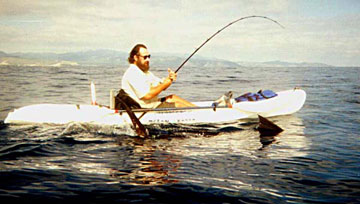
CKF owner Dennis Spike busting loose with one helluva sleigh ride... courtesy of this 120-pound sailfish that he successfully caught and released at Rancho Leonero.
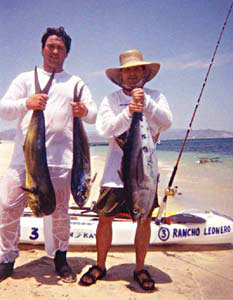
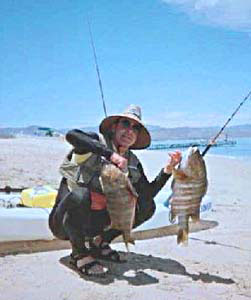
Neil and Mo, left, (two of the "Usual Suspects") hoisting ahi and mahi- mahi caught off the 'yaks in Palmas Bay; and Mike Allen, kayak fly-fishing expert and CKF guide, with some smaller barred pargo taken off the inshore reefs.
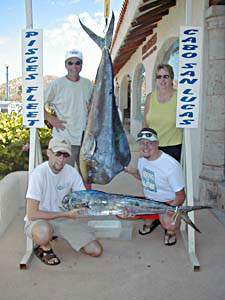
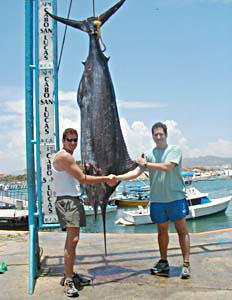
In Pisces Fleet action last week, Joe Williams and party from Cypress, Texas, left, caught some nice dorado on their trip aboard Valerie, and Bill and Dave Shraga, from New York, landed a 450-pound blue on Ruthless.
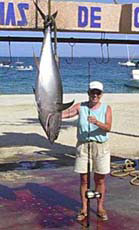


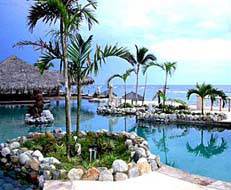
Scenes from Bill Klimas' super week at Hotel Palmas de Cortez.

Larry Crass from the San Fernando Valley and his big tuna.
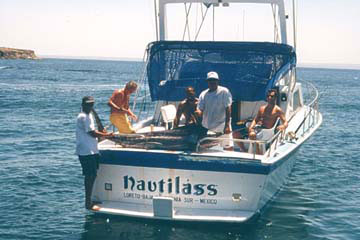
New cruiser service in La Paz, Memo Chavez' 32-foot Luhrs, the Nautilass, shown here with Captain Juanjo, deck hand, David, and angler, Mike Cadena.
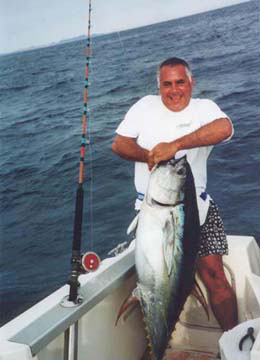
A nice yellowfin tuna caught out of Hotel Las Arenas last week.
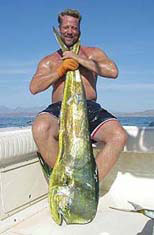
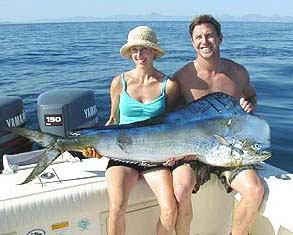
El Fuerte Sport Fishing anglers scored on big, mid-summer dorado last week.

We have had friends here from Canada and have been sloughing off! Anyway, the fishing has been good and more people are coming down and enjoying the catching and the weather. Come and taste the great dorado! Bye for now, Wendy, Villas de Loreto.
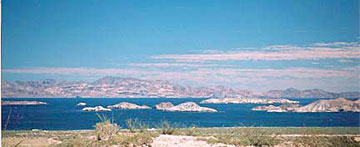
Beautiful Bahia de los Angeles last week. Photo satellite-transmitted by Abraham Vazquez.
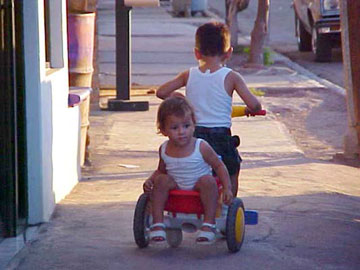
Wow! She's growing up fast! That's Pam Bolles' daughter, Damiana, getting a lift in Loreto. Damiana, by the way, is the newest staff member of Baja Big Fish Company. See Pam's report in the Loreto section, above.
Baja coastal fishing reports and articles.
Ensenada fishing reports and articles.
Puerto Santo Tomas fishing reports and articles.
Erendira fishing reports and articles.
San Quintin fishing reports and articles.
Magdalena Bay fishing reports and articles.
Cabo San Lucas fishing reports and articles.
San Jose del Cabo (Los Cabos) fishing reports and articles.
East Cape fishing reports and articles.
La Paz fishing reports and articles.
Loreto fishing reports and articles.
Mulege fishing reports and articles.
Santa Rosalia fishing reports and articles.
Bahia de los Angeles (L.A. Bay) fishing reports and articles.
San Felipe fishing reports and articles.
Rocky Point (Puerto Penasco) fishing reports and articles.
San Carlos (Sonora) fishing reports and articles .
Mazatlan fishing reports and articles .
Puerto Vallarta fishing reports and articles.
Ixtapa Zihuatanejo fishing reports and articles.
Huatulco fishing reports and articles.
Cancun fishing reports and articles.
Mexico coastal fishing reports and articles.
Mexico Fishing Home Page < Mexico Fishing News Archives < Fishing Report
Copyright ©

